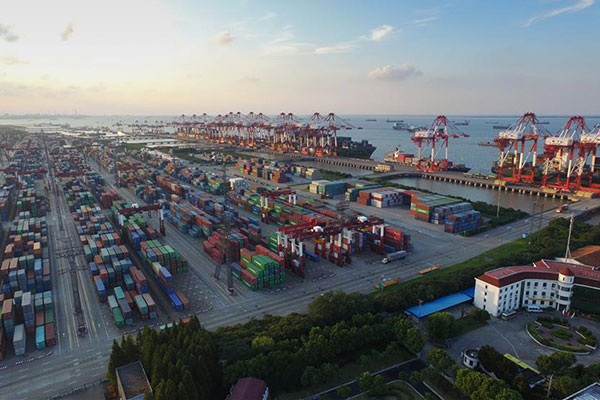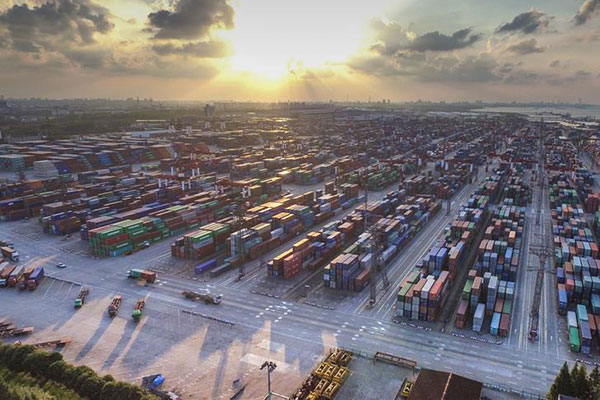
Aerial photo taken on Sept 19, 2015 shows the Waigaoqiao container pier of the Shanghai free trade zone (FTZ) in Shanghai, east China. China’s total export and import values in 2015 decreased 7 percent year on year to 24.59 trillion yuan, according to data released by the General Administration of Customs (GAC) on Jan 13.[Photo/Xinhua]
BEIJING — China reported better-than-expected trade data in December, with exports posting an unexpected rise while an import slump moderated.
Exports in yuan-denominated terms climbed 2.3 percent year on year in December, compared with November’s 3.7 percent drop, while imports declined 4 percent, an improvement over the previous month’s 5.6 percent fall, leaving a widening trade surplus of 382.1 billion yuan (57.9 billion $), according to data from the General Administration of Customs (GAC) released on Jan 13.

Aerial photo taken on Sept 19, 2015 shows the Waigaoqiao container pier of the Shanghai free trade zone (FTZ) in Shanghai, east China. China’s total export and import values in 2015 decreased 7 percent year on year to 24.59 trillion yuan, according to data released by the General Administration of Customs (GAC) on Jan 13. [Photo/Xinhua]
“A return to growth for exports after five months of contraction is a reassuring sign, and further evidence that the economy is not teetering on the brink,” Bloomberg economist Tom Orlik said in a report to clients.
Total foreign trade values in Dec edged down 0.5 percent year on year to 2.48 trillion yuan.
For the whole year of 2015, exports fell 1.8 percent year on year to 14.14 trillion yuan, while imports declined 13.2 percent to 10.45 trillion yuan.
That led to a 2015 trade surplus of 3.69 trillion yuan, an increase of 56.7 percent from a year earlier, data showed.
Last year, the country’s total export and import values decreased 7 percent year on year to 24.59 trillion yuan.
GAC spokesperson Huang Songping attributed the foreign trade decline in 2015 mainly to falling commodity prices and sluggish demand.
Crude oil imports in 2015 rose 8.8 percent to 336 million tonnes while that of iron ore climbed 2.2 percent to 953 million tonnes, the GAC reported.
Huang warned about upcoming difficulties, saying feeble global economic growth and sluggish external demand would not see evident improvement in 2016.
In dollar-denominated terms, China’s exports fell for the sixth consecutive month, by 1.4 percent from the same month in December, but the pace of fall decelerated from November’s 6.8 percent decline. Imports decreased 7.6 percent year on year, receding for the 14th consecutive month, but improving from the previous month’s 8.7-percent drop.
Economists had forecast an eight-percent fall for exports in December and an 11-percent decline for imports.
Despite a tough situation, positive signs emerged for foreign trade in 2015. General trade saw a bigger share of the economy at 54 percent and progress was also made in China’s efforts to diversify its trade partners, Huang said.
Last year, trade with the United States, the second-biggest trade partner, rose to 3.47 trillion yuan in 2015 from 3.41 trillion yuan the previous year.
Meanwhile, trade with emerging markets including India and ASEAN were better in overall performance in 2015, Huang said, adding that trade with India increased 2.5 percent year on year.
The increases were not made without cost, though. In 2015, trade with the European Union, the country’s biggest trade partner, and ASEAN, the third-largest partner, edged down to 3.51 trillion yuan and 2.93 trillion yuan, respectively, from 3.78 trillion yuan and 2.95 trillion yuan in 2014.
Private firms pocketed 9.1 trillion yuan or 37 percent of the total foreign trade volume last year, 2.5 percentage points more than the previous year.
Huang also highlighted the structural optimization of exports. During the past year, China’s export of mechanical and electrical products grew 1.2 percent year on year to 8.15 trillion yuan, accounting for 57.7 percent of the total exports of the year, 1.7 percentage points more than 2014.
In contrast, exports of seven traditional labor-intensive products including clothing and shoes fell 1.7 percent to 2.93 trillion yuan, accounting for 20.7 percent of the total exports in 2015.
China’s trade has improved during the past year due to low commodity prices as the country imported more iron ore and crude oil products, according to Huang.
